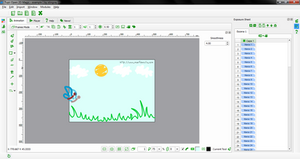Software:Tupi
 Tupi running on Windows 7 | |
| Original author(s) | MaeFloresta |
|---|---|
| Developer(s) | Gustavo González |
| Stable release | 0.2.11 (Abequar)
/ May 23, 2018 |
| Repository | github |
| Written in | C++ / Qt |
| Operating system | Unix-like, Windows, Mac OS X |
| Type | Animation software |
| License | GPLv2 |
| Website | www |
TupiTube (formerly Tupi) is a free 2D animation software, designed by Colombian developer Maefloresta, this application founded on a philosophy of open community handling a GPLv3 license. TupiTube aims to be a platform for introduction to the basic concepts of 2d animation, designed with a minimalist structure and accessible to all ages. It has a mobile version in the main appstores of the market and another in desk for linux, microsoft and mac. is a software application for the design and creation of 2D animation. This tool, inspired by and for animators, is being developed by an open community. It is covered under the terms of the GNU General Public License v2, meaning that Tupi is free and open-source software.
History
Background and first versions:
Tupitube is the product of the insistence and determination of two young Colombian entrepreneurs from the city of Santiago de Cali, who in 2002, led the Ktoon initiative together with the companies Toonka FIlms and Soluciones Kazak. This aims to be a tool to encourage young people throughout Latin America, interest in the development of the animation industry.
The incentive to build a culture of animation and start developing a Latin American industry that would tend to constitute a community of digital artists, leads to the decision of design and distribution that would mark the basis of Tupi Tube, a free software compatible with the majority of operating systems.
Ktoon sets the foundations to seek the first investments in the project, where entities such as colciencias, the Sena and others push the initiative during its first years of development, this financing model sustained the project in its early development stage.
By 2010, the Ktoon developer team meets and retakes the project, now with the name of Tupi 2D Magic and later configuring Maefloresta as the developer who will maintain the vision of its predecessors, without abandoning the intention to remain as a software Free, accessible and comfortable for all the public interested in getting started.
Tupi 2D Magic, focuses its efforts on presenting itself as an experience where its users can animate, illustrate and design in different spaces, even becoming a tool in classrooms, reaching 400,000 students in India, where 3,000 schools they used it as their software of preference.
News and trajectory:
MaeFloresta is in need of continuing its brand projection and Tupi 2d Magic was deserved a restructuring, to be able to afford to grow to reach new audiences and stay in the market, this is why they transform TupiTube, with the intention of becoming institutionalized as the free 2D animation software preferred by children, young people and digital artists in training. It is in this way to pursue the goal of being a tool for artistic education in digital environments, addressing the academic possibilities that animation training can offer, actively participating in events where ICTs and educational projects converge for the creation of a culture where Technology education is also a priority. With TupiTube, the efforts of the development team begin to materialize. They receive different awards and recognitions for their efforts, for hosting TupiTube and for being an example of entrepreneurship in the digital commerce boom.
Awards and Recognitions
- Finalist of: DemoDay "best digital content team"
- Finalist of "ValleE de la Red Regional de Emprendimiento"
- KIDS CHOICE AWARDS 2017 Favorite App
- "PREMIO A LA VALENTÍA EMPRENDEDORA" gived by Carval
Features
One of the main objectives of this project from the beginning has been to provide an easy user experience, starting at the design of the GUI which allows the creation of simple animations in only 5 steps.
The software includes many features:
- Support for basic tools for vector illustration that includes rectangles, ellipses, lines, and polygons. Paths can also be created using the pen or pencil tool. The paint bucket tool can be used to fill bounded areas of vector objects.
- Raster images (sometimes called Bitmap) can be imported and used as either static backgrounds or animated assets.
- Finished animations can be exported to various file formats that include: (Ogg Theora, AVI, MPEG, SWF. Or as a sequence of images in PNG, JPEG, and SVG format.
- Basic support for tweening of positions, colors, rotation, scale, sheer, and opacity has been added to recent releases.
- The Library panel allows for the organization and reuse of imported media assets.
Future development
The goal of being a tool for introducing novice digital artists to the world of animation was fulfilled with the first releases. Development is focused on reaching a professional level that will allow advanced users to make professional-quality animations.
Some of the areas of future development include: particles, sound support, key frames, and morphing. Plans have also been made to have skeleton animation with bones, inverse kinematics, and pivots.
See also
References
External links
Motion graphics and animation software
| ||||
|---|---|---|---|---|
| 2D | 3D | Mix | ||
| Open-source | ||||
| Closed-source | Freeware | |||
| Commercial | ||||
| Discontinued / Legacy | ||||

